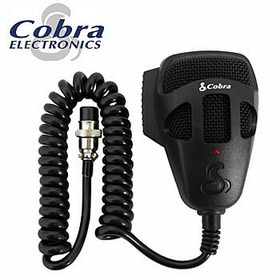CB Radio Microphones

CB radio microphones are easily the favorite parts of a CB radio set for most people. Who doesn't like talking into a microphone? CB radio microphones come in many shapes and sizes, and have evolved quite a bit, but in the end they are simply devices that transmit your voice to the masses. This article will talk about CB radio microphones and give you a few suggestions for your kit.
What CB Radio Microphones do
The purpose of CB radio microphones is simple: to take your voice and send it to the world. A microphone works by taking sound and converting it into an electrical signal. The signal is then transmitted to the transmitter, which then takes the message and emits it. The message is then received by a receiver, "decoded", and turned into an audible sound.
How they operate
Your basic CB radio microphones have a few simple components: a push-to-talk (PTT) button; a diaphragm (the piece that produces sound), and a casing. Most CB radio microphones can be used by either right-handed or left-handed people, and some are even incorporated into the set itself if it is a CB radio walkie-talkie device.
A CB radio microphone may even have a noise filter or other form of sound quality control incorporated into its design why not visit, Vietnam War Reenactments to cut down on background noise and transmit only your voice.
CB Radio Microphone Brands, Costs, and Types
The same companies that produce most of the CB radio equipment on the market also make microphones. Galaxy, Cobra, Uniden, Road King, and Astatic are the leading producers of CB radio microphones today.
Most CB radio microphones for sale today have basic features also see, Collecting World Coins such as echo control and noise filters. The more advanced microphones have noise cancellation technology incorporated into the set to increase the sound quality on the receiving end. One example is the Astatic 636L CB Microphone, which retails for $34.99 and features also look at, Sugar free Strawberry Surprise Muffins noise-cancelling technology. This is, in my opinion, an essential element to have in any microphone you buy.
Cost varies depending on how complicated your CB radio microphone is designed to be. You can buy a cheap, basic CB radio microphone for just $10 (or even cheaper if used). Or, you could spend over $100 for a high-end base station microphone, or around $60-75 for a high-end mobile microphone.
One thing to consider is fitting the microphone to the radio deck also see, RC Sherman or transmitter. Most radios are configured to accept four-pin microphones, which means your microphone must have a four-pin plug in order to be used with these sets. Most mainstream transmitter decks checkout, RC Sherman built by Cobra, Uniden, etc. are four-in devices, meaning that all four-pin CB radio microphones should work well with them.
 Collectible Guns and Firearms Collectible Guns and Firearms
Collectible guns and firearms are probably one of the oldest and most interesting hobbies that have |
 Digital Photography Techniques Digital Photography Techniques
Digital photography techniques range from good composition to effective lighting. Many digital photo |
 7 Card Stud Poker 7 Card Stud Poker
7 Card Stud poker is a type of poker game that is very similar to Texas hold em where you use five o |
 Collectible Books and Magazines Collectible Books and Magazines
Collectible books and magazines have been a popular hobby since a long time. In fact collectible coo |
 DIY Repair DIY Repair
DIY repair is something every homeowner should be familiar with. Not only will this save you a lot o |